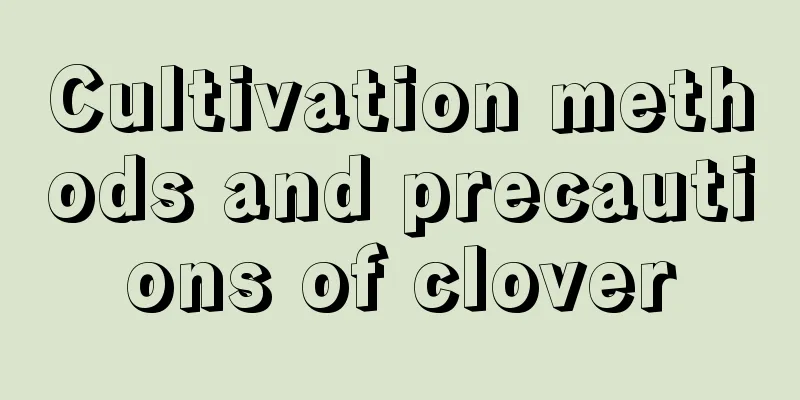Cultivation methods and precautions of clover

How to grow cloversoilThe seeds of clover are relatively small, so their ability to emerge from the soil is weak, and the seedlings are relatively slender, so they grow relatively slowly during the seedling stage. Therefore, before sowing, the soil must be prepared, shallowly plowed and debris removed to make the soil clods small. At this time, the soil becomes loose and conducive to sowing. Sowing and seed treatmentThe best time to sow clover is spring and autumn. The suitable sowing temperature should be 19-24℃. Sowing can be carried out when the spring temperature is stable above 15 degrees Celsius. Autumn sowing can be carried out in mid-to-late September. The seeds must be soaked before sowing, and the sowing depth should be 1-2cm. If it is too deep, it may cause difficulty in germination. Post-planting managementAfter sowing clover and before germination, if the soil is compacted, it should be loosened in time to facilitate germination. Because clover grows relatively slowly in the seedling stage, it is very susceptible to weeds. The soil should be loosened and weeded 1 to 2 times during the seedling stage. In addition, disease and pest control work should be done to ensure the smooth growth of clover. When the soil is dry, it is important to retain water. Keeping the soil moist is more conducive to the growth of clover. FertilizationClover belongs to the legume family, so it has the ability to fix nitrogen. However, during its seedling stage, a small amount of nitrogen fertilizer is still needed to help the seedlings grow strong, otherwise the plants will be short and the leaves will turn yellow. After the seedlings grow strong, you can also apply a certain amount of phosphorus and potassium fertilizers. Things to note when growing cloverPests and diseasesClover has common diseases and pests. Sclerotinia and viral infection are the main diseases of clover. If clover is infected with the disease, we can either pull out the diseased plants to cut off the source of the disease , or use chemical agents. The more common pests include leafhoppers, cutworms, and white cabbage butterflies. We need to use special insecticides or pesticides to kill these pests. |
<<: What are the varieties of clover?
>>: The difference between cat's eye arrowroot and peacock arrowroot
Recommend
Advantages and Disadvantages of Brass Band Rose
Brass Band is a rose variety from the United Stat...
What is the function of wine bottle orchid
The ornamental effect of wine bottle orchid The s...
Can Guanyin bamboo be grown in the bedroom?
1. Can it be placed in the bedroom? Speaking of t...
What fertilizers are needed for strawberries to be sweet (what fertilizers are suitable for strawberries to grow strong)
Strawberry is one of the popular fruits that is d...
How to propagate new bulbs of tulips (how to cultivate and plant bulbs of tulips)
Tulips are relatively precious flowers abroad. Th...
What to do if the spider plant has root rot
Initial maintenance Reduce watering If the roots ...
How to grow water chestnuts to achieve high yields?
Ginger, also known as wild ginger and wild ginger...
How to plant succulents for the first time
1. First planting method 1. Seed sowing: When pla...
Lavender pruning before summer
Lavender needs pruning before summer When growing...
When does the cold water flower bloom?
Will the cool water flower bloom? Pilea will bloo...
To be a beautiful woman, start by growing flowers and vegetables
Maybe you only have a balcony, but it can still b...
How to plant lotus with lotus root and how to maintain it after planting
1. How to plant lotus root 1. Time selection: The...
How to reproduce the thorny rose
Propagation by division Breeding time: Can be car...
Cotton Origin
1. Cotton Origin Cotton originated in the subtrop...
How to make the rubber tree grow thicker
1. Topping We can top it off, but we need to pay ...









